Cracking the Impact: What Size Hail Will Damage a Roof?
When it comes to protecting your home, understanding “what size hail will damage a roof” is crucial. Generally, hailstones larger than 1 inch in diameter—comparable to the size of a quarter—pose a threat to most roofing materials. This article will delve into how different sizes of hail can impact roofing structures, the factors that increase vulnerability, and steps you can take to assess and repair potential damage.
Key Takeaways
-
Hail formation is influenced by updrafts in thunderstorms, and the damage it can inflict on roofs largely depends on hailstone size, speed, wind conditions, and the type and state of the roofing material.
-
Hailstones can range from pea-sized to golf balls and beyond, each size with differing damage potential. Roofs start experiencing significant damage with hailstones 1 inch in diameter or larger, though damage can be influenced by other factors like roofing materials and barriers.
-
After a hailstorm, it’s crucial to safely inspect for damage both visible (like dents and cracked shingles) and hidden (such as internal splitting and loss of granules), and take swift action by documenting damage and contacting professionals for inspection and insurance claims.
Understanding Hail and Its Potential for Roof Damage
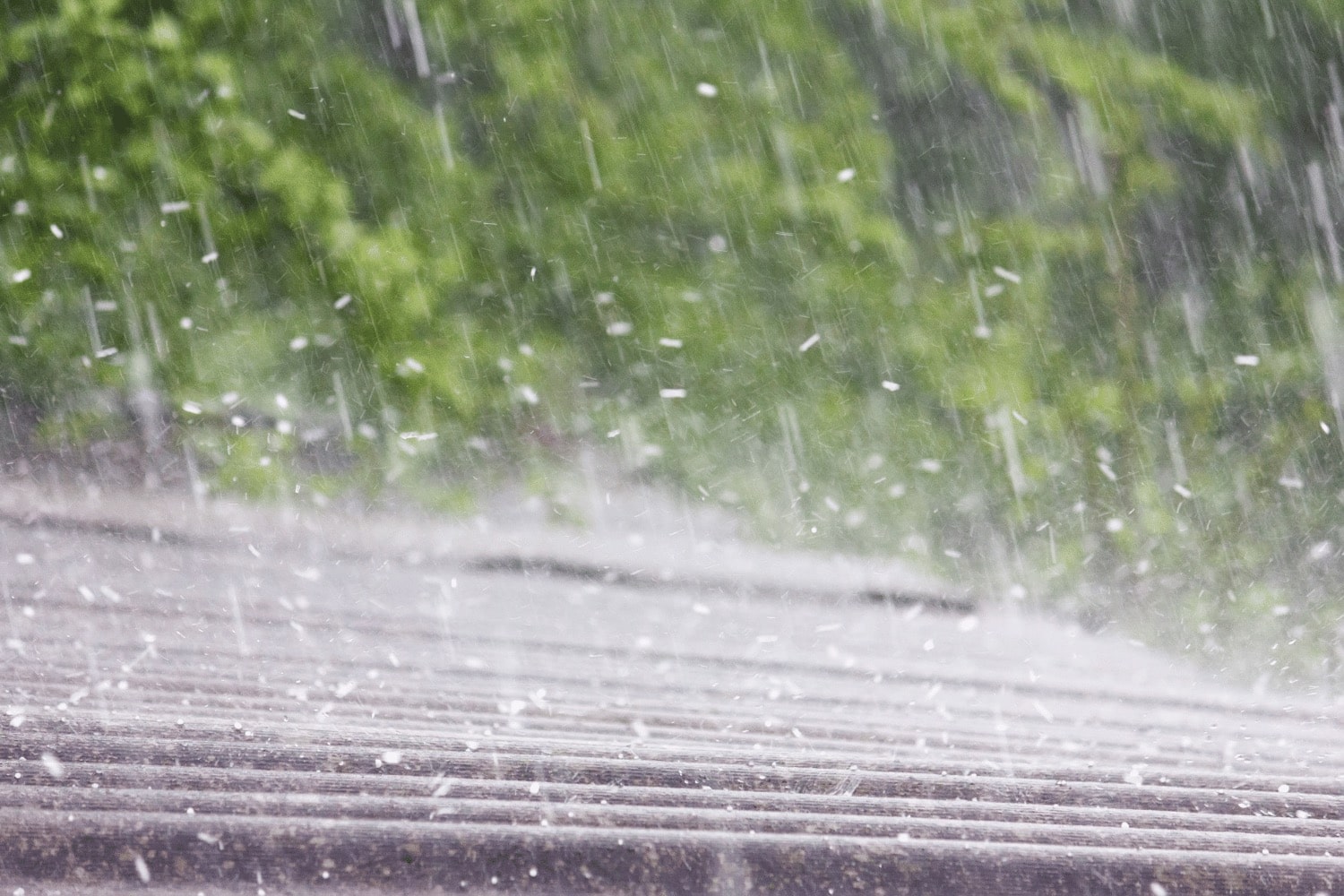
Have you ever pondered hail formation? It originates within thunderstorm updrafts, with air currents lifting raindrops into the freezing upper levels of clouds. This leads to the formation of hailstones, which grow in size each time they collide with supercooled water droplets that freeze on contact. Eventually, these hailstones become too heavy or the updraft weakens, causing them to rain down on the earth, potentially causing a hailstorm of problems for your roof.
Factors such as hailstone size, impact speed, and wind conditions determine the damage potential of hail. These factors can alter their trajectory and velocity, making wind-driven hail particularly destructive and capable of causing storm damage.
The ability of hail to damage roofing systems depends on the hailstone’s impact force, which is affected by its size, speed, and wind direction, as well as the condition and type of the roofing materials.
The Science of Hail Formation
Atmospheric conditions and the strength of wind updrafts play a key role in determining the size of hailstones. Larger hailstones develop from stronger updrafts that allow them to absorb more supercooled water droplets over time. The longer a hailstorm lasts, the more opportunity hailstones have to be carried by updrafts, increasing in size before they finally fall to the ground.
But not all hailstones are smooth and round. Some hailstones collide and freeze together within the storm cloud, leading to an irregular and spiky appearance. These are known as spiked hail, another potential threat to your roof.
Thus, hail storms aren’t just a cascade of ice; they are intricate atmospheric events with significant destructive potential.
Hail Size and Roof Vulnerability
Now that we understand how hail forms, let’s explore how different hail sizes affect roof vulnerability. Hail can cause a variety of damages to your roof, depending on its size and the type of roofing materials. For example, hail can cause:
-
Punctures
-
Tears
-
Fractures
-
Granule displacement on asphalt shingles
-
Cracks or shatters on harder roofing materials like clay or concrete
Displaced granules from asphalt shingles due to hail expose the underlying asphalt to sun rays, which can lead to accelerated deterioration and damage. This is why even minor hail impact should not be taken lightly as it can lead to significant long-term damage.
Therefore, keep in mind that not only the size of hail but also the material of your roof determines the potential damage.
Thresholds of Destruction: Recognizing Hail Sizes That Harm Roofs
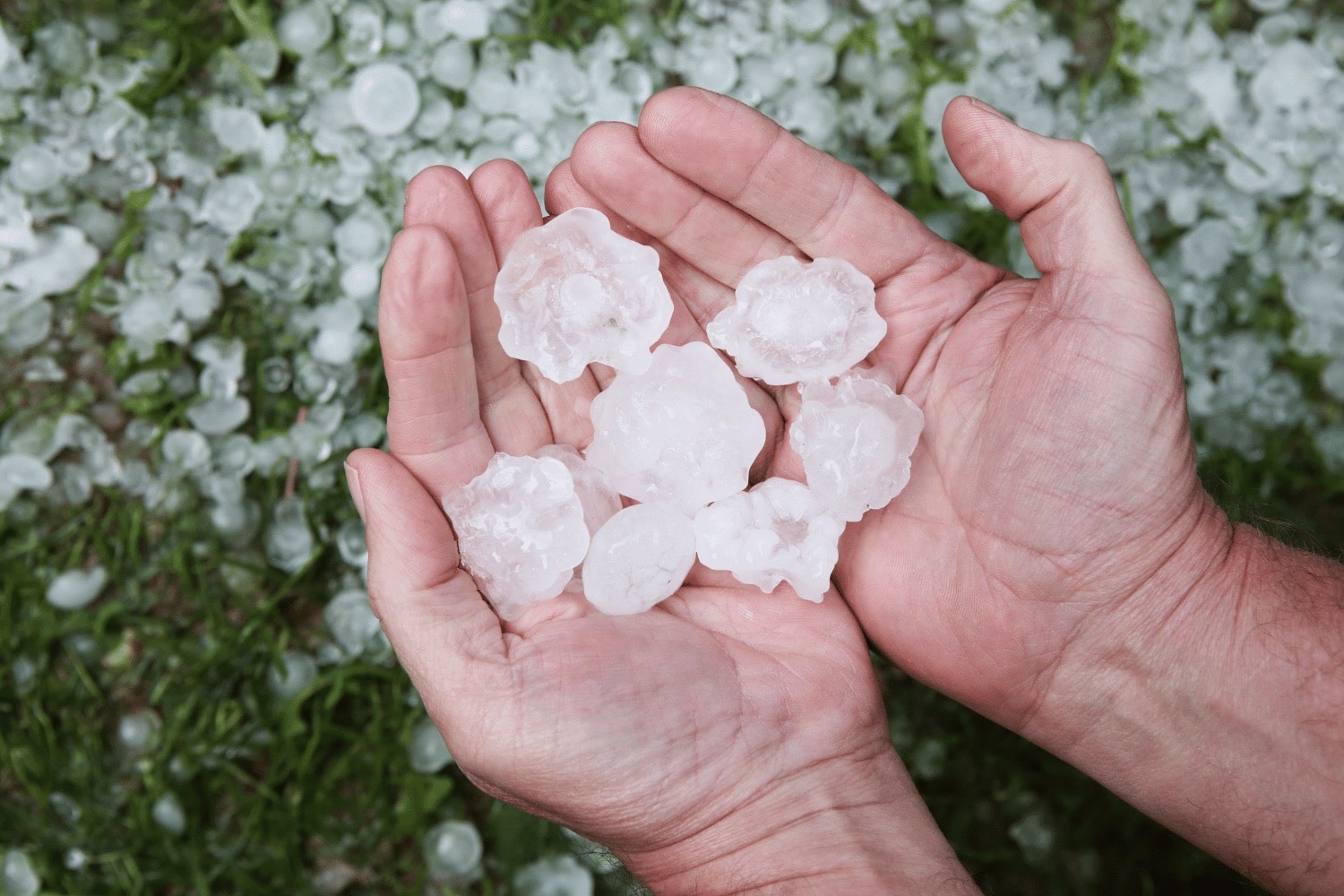
Every homeowner should be aware of the hail sizes that can cause damage to roofs. These sizes range generally from pea-sized to much larger sizes, displaying a broad spectrum of potential impacts. While marble-sized hail typically does not damage roofs, hailstones that are 1 inch and above can cause issues ranging from shingle bruising to penetrating softer roof parts. Hailstones over 2 inches cause significant, severe damage.
But, factors like wind conditions, hailstone density, roofing materials, and the presence of barriers can influence roof damage after a hailstorm, not just size. Therefore, it’s important to understand not just the size of the hailstones, but also the multiple factors that can influence their destructive potential.
From Pea-Sized to Golf Balls: A Spectrum of Hail
Hailstones come in a variety of sizes, often compared to common objects to help estimate their potential for damage. For instance, hail that is approximately one inch in diameter or smaller, roughly the size of a quarter, is typically not substantial enough to cause significant damage. However, as the size increases, so does the potential for damage. Hail with a diameter of 1.75 inches, similar to the size of a golf ball, has the potential to cause significant damage to vehicles and buildings. This is due to its larger size and impact force..
To give you an idea of the upper end of hailstone size, let’s consider the largest hailstone recorded in the United States, which measured an astounding 8 inches in diameter and weighed nearly 2 pounds! This should give you a clear understanding of the serious damage that large hailstones can inflict.
When to Be Concerned: Identifying Risky Hail Dimensions
Identifying specific hail sizes that can cause damage is crucial for understanding the risk to roofing structures. Fiber-cement siding is known for its durability and resistance to hail, making it an excellent choice for roof protection against significant hail damage. Therefore, homeowners should be concerned about potential roof damage whenever hailstones reach a diameter of at least one inch. This sets the threshold for when homeowners should begin to assess for damage.
However, it’s important to remember that hail damage is not solely determined by the size of the hailstones. The type and condition of your roofing materials, as well as the angle and velocity at which the hailstones hit your roof, can also significantly affect the extent of the damage. Therefore, it’s always advisable to conduct a thorough inspection or consult a professional roofing contractor after any hailstorm, irrespective of the perceived hail size.
Inspecting for Hail Roof Damage: Key Indicators
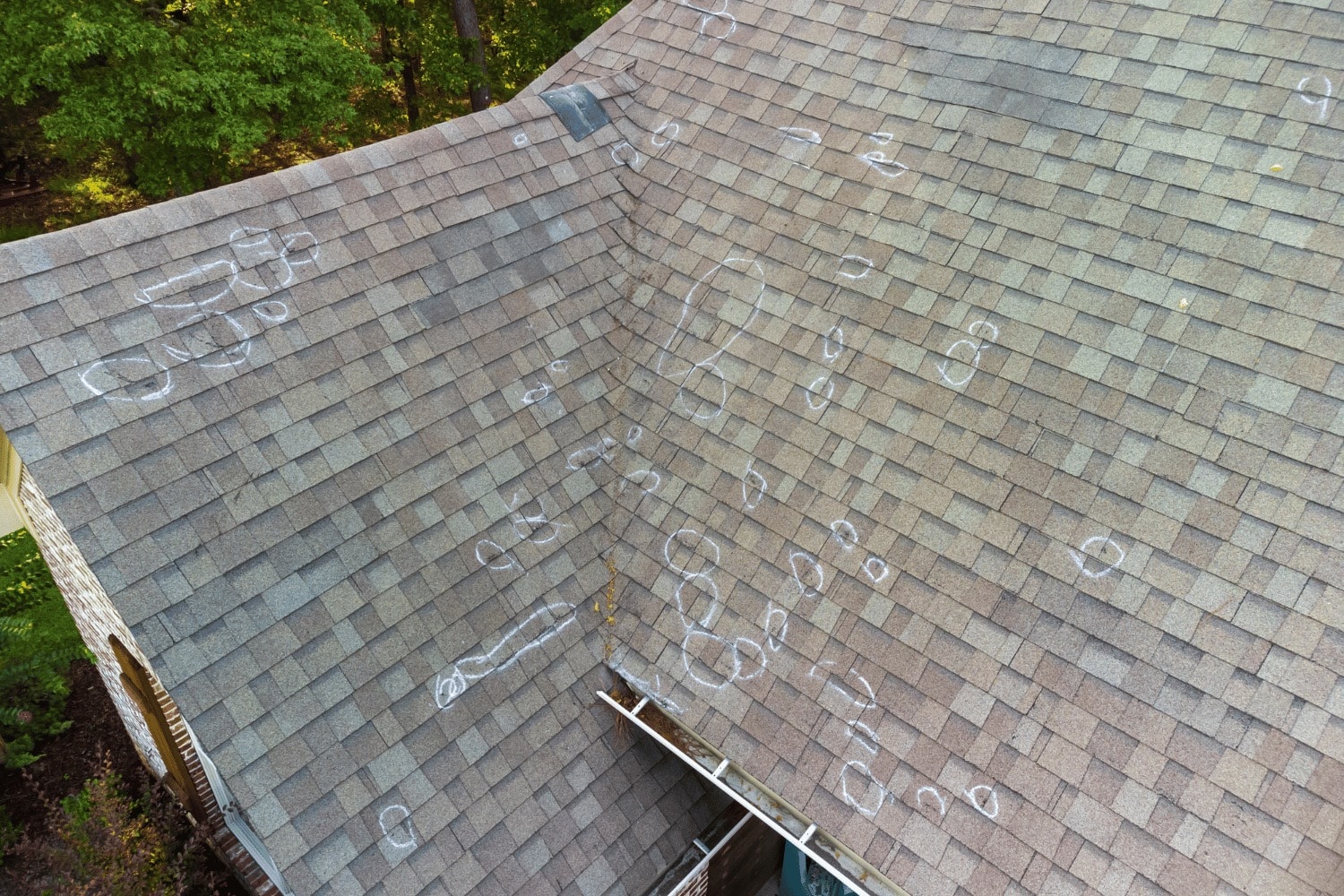
Following a hailstorm, it is crucial to identify hail damage by conducting an inspection of your property. Signs of hail damage can include:
-
Small, unnoticeable damage that requires a trained eye to spot
-
Dents in siding, gutters, downspouts, and damage to exterior items like outdoor furniture
-
Damage to roofing materials and components such as flashing, roof vents, skylights, gutters, and chimney caps or covers
-
Damage to other items like air conditioning units
It is important to assess all these areas for hail impact to ensure any damage is identified and addressed.
Inspecting a roof for hail damage necessitates caution. It’s advisable to wear a good pair of soft-soled shoes or roofing boots, use a ladder in perfect working condition, and have basic safety knowledge. If you’re uncomfortable or unsure about assessing the damage yourself, consider calling a professional roofing contractor.
Spotting the Signs: External Clues of Hail Hits
What are the external signs of hail damage you need to keep an eye out for? Cracked or broken windows, damaged siding, and dented gutters are clear external indicators of hail damage observable from the ground. Damage to outdoor features such as splatter marks on driveways, damaged mailboxes, broken branches and stripped flowers can also signal previous hail activity.
When it comes to your hail damaged roof, roof-specific hail damage can be identified by inspecting the roof for:
-
dented flashing
-
dented vents
-
dented plumbing boots
-
using chalk to reveal hail impact points on chimney covers
Remember, these external signs are just the tip of the iceberg, and there could be more extensive damage hidden underneath the surface.
Unseen Complications: Hidden Hail Impact
Hail damage can manifest in various ways, some of which may not be immediately visible. Here are some signs to look out for:
-
Subtle dents on roofs and roof fixtures
-
Internal splitting of shingles (may require closer inspection)
-
Dislodged shingle granules, leading to a loss of protective coating
-
Evidence of granule accumulation in gutters
If you suspect hail damage, it’s important to have a professional inspection to assess the extent of the damage and determine the necessary repairs.
These seemingly minor issues can compromise the integrity of your roof by making it more susceptible to water leaks and further damage. Therefore, even if hail was small, a thorough inspection of the roof is crucial after hailstorms, as smaller hailstones can still cause unseen damage.
Rapid Response: What to Do After a Hail Storm
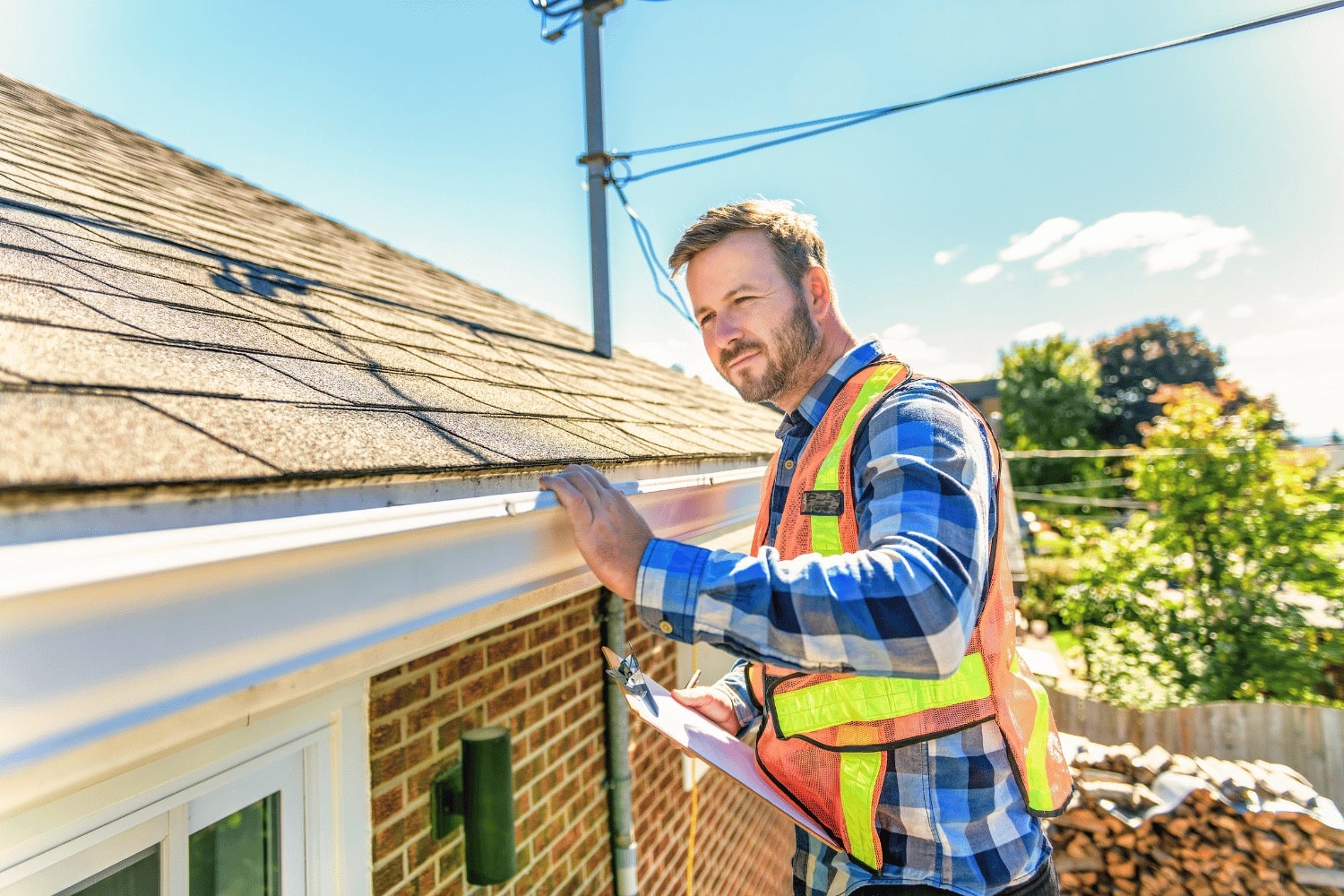
While the aftermath of a hailstorm can be stressful, a swift response can alleviate the damage. Following a hail storm, homeowners should:
-
Gather evidence for a hail damage claim by documenting the number of hail marks per specific area
-
Take clear photos and videos of all the damage
-
Save any related invoices and receipts
It’s important to address roof repairs promptly after noticing hail damage to prevent further roof damage issues.
However, immediate action is crucial as insurance may not cover additional damages occurring after the initial hail event. Therefore, the initial hail damage assessment should be done from the ground without climbing onto the roof to ensure personal safety. If a closer inspection is necessary, precautions must be taken to safely access the roof, such as using proper safety equipment or consulting with professionals.
Initial Assessment and Safety Precautions
Safety should be the top priority during the initial assessment of hail damage. Climbing onto the roof can be hazardous, especially if the surface is wet or damaged. Thus, the initial assessment should be conducted from the ground, looking for visible signs of damage such as missing shingles, dented gutters, or broken windows.
If a closer inspection is necessary, precautions must be taken to safely access the roof. This includes using a sturdy ladder, wearing appropriate footwear, and avoiding the roof during inclement weather. In such cases, it may be more prudent to call a professional roofing contractor who has the necessary safety equipment and experience to carry out a comprehensive inspection.
Contacting Your Trusted Roofing Contractor
After your initial assessment and documentation of the hail damage, it’s time to bring in the professionals. Hail damage inspections by professionals are critical for homeowners to receive fair insurance coverage for the losses sustained from hail damage. It’s important to find a roofing contractor who is trusted and has experience with insurance-related repair projects after a hail storm.
Rapid Roofing, a professional roofing contractor, excels in helping homeowners navigate the insurance claims process for roof damage. They can not only assist with the inspection but also provide valuable advice and resources to ensure that you get the maximum coverage possible for your hail damage claim.
Navigating Insurance Claims for Hail Damage
Filing a hail damage insurance claim can be intimidating, especially with some insurance companies potentially exploiting homeowners. That’s why it’s crucial to understand your rights as a policyholder and the steps you need to take to ensure that you receive fair compensation for your losses. Before filing a claim, homeowners should understand the extent of the damage, check policy coverage, and note the dates of hail storms.
However, dealing with insurance claims can be complex and it’s generally advised to avoid giving recorded statements to claims adjusters to prevent undermining the claim. If the initial settlement offer does not fully cover the hail damage, homeowners have the right to negotiate with insurance adjusters.
Filing an Insurance Claim: Steps and Strategies
Several steps and strategies can facilitate the process and ensure a positive outcome when filing an insurance claim to cover hail damage. First, contact your insurance agent or representative if you suspect hail damage to your roof to discuss the next steps for assessment and repair.
Understanding insurance terms is crucial during this process. For instance, the ‘Cosmetic Damage Exclusion’ introduced in 2013 by the American Association of Insurance Services allows insurers to avoid coverage for cosmetic damage, which could affect hail damage claims. Before your roof insurance claim is approved, avoid signing any contracts or agreements with roofing companies to prevent locking yourself into potentially unfavorable terms.
Partnering with Rapid Roofing for Claim Support
Partnering with a professional roofing company like Rapid Roofing can significantly streamline the insurance claim process. They specialize in helping homeowners navigate insurance claims for roof damage, ensuring a smooth and hassle-free experience.
To prevent insurance companies from denying roof replacement claims, it’s critical to have Rapid Roofing inspect the roof alongside the insurance adjuster. This way, they can provide an accurate estimate of the damage and help you negotiate a fair settlement with the insurance company.
Preventive Measures: Protecting Your Roof from Future Hail
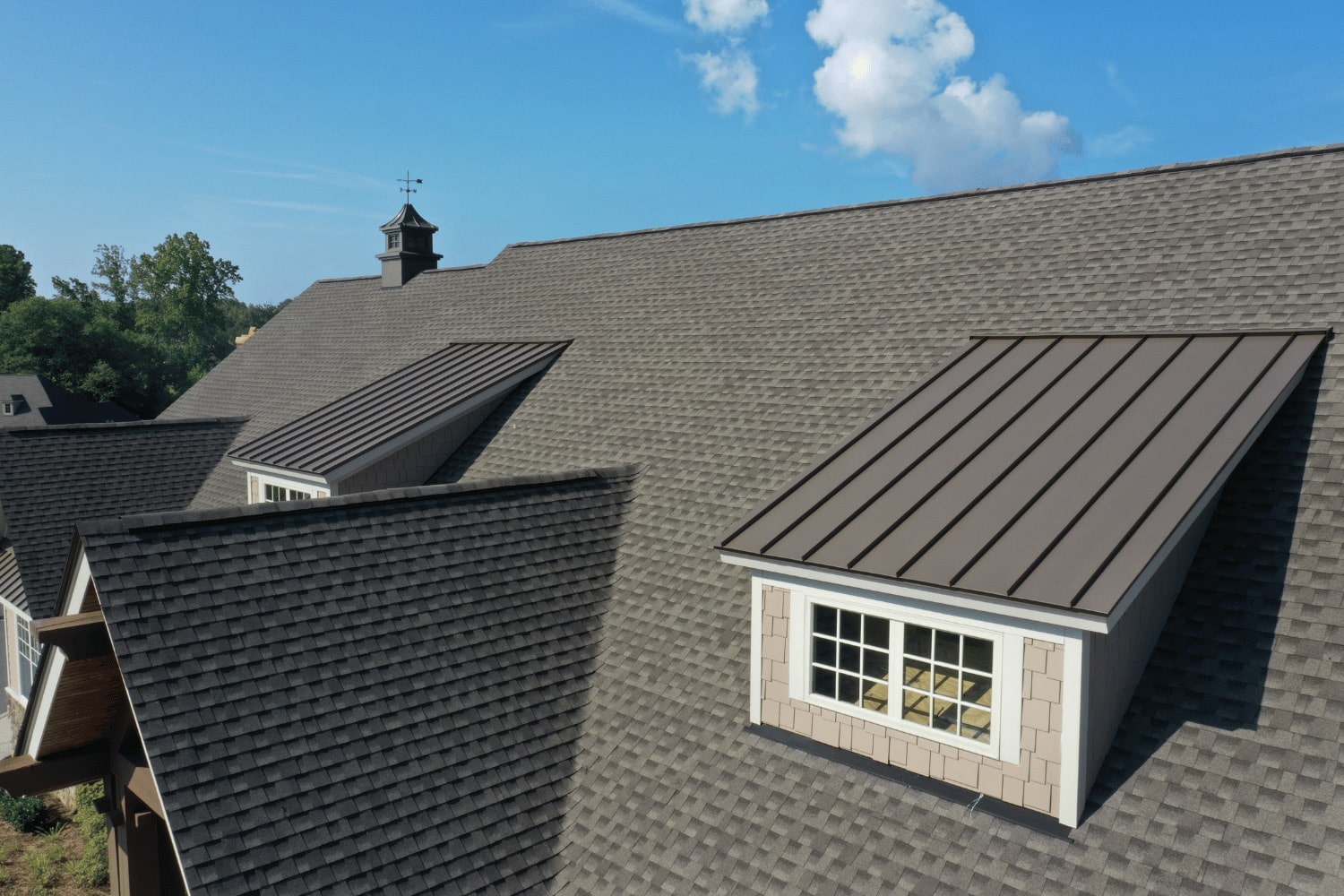
Despite the stress of dealing with hail damage, preventive measures can shield your roof from future hailstorms. Installing impact-resistant shingles, like Class 4 shingles, can significantly enhance a roof’s defense against hailstorms. Homeowners may even qualify for insurance discounts by using hail-resistant roofing materials such as Class 4 shingles.
Impact-resistant roofs have several benefits:
-
They maintain their curb appeal and waterproofing abilities longer, leading to less frequent needs for roof replacements.
-
Roofs with steeper slopes are less susceptible to hail damage as they enable hail to slide off more readily.
-
To further protect a roof from potential hail damage, trimming trees and shrubs in the vicinity is recommended to prevent branches from hitting the roof during storms.
Choosing Resilient Roofing Materials
Choosing roofing materials should prioritize impact resistance. Class 4 impact-resistant shingles are specifically designed to withstand severe weather conditions, such as hail storms. These shingles can resist impacts from 2-inch steel balls without cracking, indicating a high level of protection for roofs.
Metal roofing is another excellent choice for hail resistance. High-grade zinc-aluminum alloy steel roofing offers warranties that cover hailstone penetration for hail up to 2.5 inches in diameter. These metal roofing systems not only provide high durability against hail but also boast a lifespan of 40 to 100 years based on the quality of the material.
Regular Maintenance and Inspections
To preserve roof integrity and lessen the impacts of hail damage, regular maintenance and roof inspection are vital. Even impact-resistant roof shingles need regular inspections to ensure they remain effective, especially after severe storms.
Having professional annual inspections conducted after the first five years of shingle installation is recommended. Early detection and immediate action on any issues identified during inspections can greatly minimize the consequences of roof hail damage.
Summary
In conclusion, while hailstorms can cause significant damage to your roof, understanding the factors that influence hail formation, recognizing hail sizes that harm roofs, and knowing the key indicators of hail damage can equip you to effectively navigate the aftermath of a hailstorm. Partnering with a trusted roofing contractor like Rapid Roofing can provide invaluable assistance during inspection and insurance claims, and implementing preventive measures can protect your roof from future hail. Remember, a proactive approach is your best defense against hail damage.
Frequently Asked Questions
What is the process of hail formation?
Hail forms when air updrafts carry raindrops into upper level clouds where temperatures are below freezing, causing the raindrops to freeze and form hailstones, which grow in size by colliding with supercooled water droplets.
How does hail size affect roof damage?
The size of hailstones directly affects the extent of roof damage. Larger hailstones, especially those over 2 inches, can cause severe damage to roofs.
What are the signs of hail damage on a roof?
Look for subtle indications like small, unnoticeable damage or more obvious signs such as dents in siding, gutters, and outdoor furniture to identify hail damage on a roof.
How can I protect my roof from future hail damage?
To protect your roof from future hail damage, consider installing impact-resistant shingles, conducting regular maintenance and inspections, and trimming nearby trees and shrubs to prevent potential damage during storms. These measures can help safeguard your roof from hail damage.
Why should I contact a professional roofing contractor after a hailstorm?
You should contact a professional roofing contractor after a hailstorm to get a thorough inspection of your roof for hail damage, help with insurance claims, and ensure fair compensation for your losses. It’s important to have an expert assess the damage to your roof to ensure all necessary repairs are made promptly.

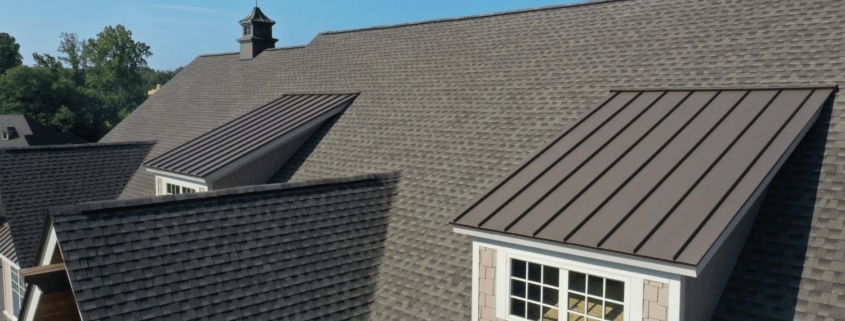
 Residential Roofing
Residential Roofing Storm Damage
Storm Damage Multi-Family Homes
Multi-Family Homes
